On October 7, 2023, the Islamic Resistance in Iraq, an umbrella organization of Iran-backed militias in the country, claimed to have launched a drone at the powerplant in Hadera in Israel. In a message posted on its Telegram channel, the organization described the attack as part of its "ongoing resistance to the occupation and assistance to our people in Gaza, and a response to the acts of massacre perpetrated by the oppressive entity [i.e. Israel] against Palestinian civilians…"[1] This message is one of more than a hundred claims of responsibility issued by the Islamic Resistance in Iraq for drone and rocket attacks against Israel since Hamas' deadly massacre on October 7, 2023. The claimed attacks were on a wide range of targets across Israel, from the Golan Heights in the north to Eilat in the south, and from the Dead Sea in the east to Haifa in the west, including army bases, infrastructure facilities, seaports and airports. In one case, the militias published a video in which Akram Al-Kaabi, secretary-general of the Al-Nujaba militia, which is a member of the Islamic Resistance in Iraq, is seen taking part in preparing a drone for an attack on Eilat.
The Islamic Resistance in Iraq is an umbrella organization of several Shi'ite Iraqi militias supported by Iran that appear on the U.S. list of designated terrorist organizations. Formed a few days after October 7, it includes the Hizbullah Brigades, the Al-Nujaba Movement, the Sayyid Al-Shuhada Brigades, and the Ansar Allah Al-Awfiya Movement. Initially, the militias focused on attacking American targets in Iraq and in Syria, apparently exploiting the Gaza war to renew their activity against the Americans after suspending it for almost a year under pressure from the Iraqi government and from Shi'ite members within it. However, in late January 2024, following U.S. pressure that included attacks on the militias and warnings to Iran, the militias once more suspended their actions against the Americans, and instead increased their attacks on targets in Israel. This second hiatus in the action against the Americans lasted until late July, when the attacks on U.S. bases in Iraq and Syria resumed.[2] Militia spokespersons clarified that the hostilities had been renewed due to the lack of progress in the talks between the U.S. and Iraq about withdrawing the American forces from the country and also because of America's support for Israel. They also threatened that "a renewal of the escalation against the U.S. is imminent."[3]
It should be noted that the efficacy of the Iraqi militias' attacks on Israel, if they in fact took place, is unclear. With the exception of a few instances in which the IDF spokesperson announced the detection or interception of drones or rockets arriving from "the east," i.e. from Iraq, and from Syria, and several reports in the Arab media about the discovery of drone wreckages of drones in northern Jordan – apparently launched from Syria or the Syria-Iraq border – there are no indications that the alleged drones and rockets reached Israel or hit their targets, as claimed by the Islamic Resistance in Iraq. In most of the cases the rockets and the drones were presumably intercepted by Israel, the U.S. or Jordan before they reached Israeli territory.
However, despite this, the attacks on Israel are a significant development in the activity of the Shi'ite Iraqi militias, which previously operated mainly in Iraq and Syria, against U.S. interests there and also against alleged "Zionist interests" in the Kurdish region in northern Iraq. The introduction of the Iraqi militias as another aggressive element against Israel is part of Iran's vision and strategy of "the unity of the fronts," which calls for the involvement of all the components of the resistance axis in fighting Israel and the U.S. on it behalf. Hamas' October 7 attack provided Iran with an opportunity to implement that vision, as manifested by the strikes against Israel carried out by the Iran-backed militias on several fronts: in Lebanon, Syria, and for the first time also Yemen and Iraq. Senior officials in the Iraqi militias assert that their operations since October 7 have been coordinated with the other members of the resistance axis and are conducted from a joint operations room. During this period, the militias have also strengthened their ties with the Palestinian factions, as well as with Yemen's Iran-backed Ansar Allah movement (the Houthis). In fact, the Houthis and the militias have recently announced that they are cooperating on the operative level and carrying out joint attacks against Israel, although the details of this cooperation are still unclear.
This report reviews the attacks against Israel claimed by the Iraqi militias in the recent months.
The Iraqi Militias Obey Iran As Part Of The Resistance Axis And Its Joint Operations Room
For many years now, dozens of Shi'ite militias supported and sponsored by Iran have been operating in Iraq, chief of them the Hizbullah Brigades and Al-Nujaba terror organizations, which view Iran's Supreme Leader Ali Khamenei as their religious authority, although they also underscore their loyalty to Ayatollah Ali Al-Sistani, the religious leader of the Shi'ites in Iraq. Most of the militias operate on two levels: as independent organizations, some of which have a political arm that is actively involved in the political system in Iraq, and as active members of Al-Hashd Al-Sha'bi (Popular Mobilization Units, PMU). The PMU was established in 2014 as an umbrella organization of numerous militias, most of them Shi'ite, with the aim of fighting the Sunni jihad organization ISIS, with the support of Iran and in accordance with a religious ruling by Ayatollah Sistani.
The establishment of the PMU as a force to combat ISIS allowed the militias to consolidate their status and their legitimacy as armed organizations. In an attempt to regulate the activity of the PMU, in 2016 Iraq passed a law that subordinated them to the prime minister and made them part of the Iraqi armed forces. However, despite this measure, most of the militias remain loyal to the Iranian regime, which maintains direct and close contact with the PMU and with most of its member militias.[4]
Some of the militias, such as Al-Nujaba, have a headquarters in Tehran, and their leaders visit Iran and meet with government officials there, including members of Iran's Islamic Revolutionary Guard Corps (IRGC), who in turn visit the offices of the militias when they come to Iraq.
These Shi'ite militias consider themselves inseparable from the resistance axis, led by Iran, and, since October 7, their leaders have emphasized their commitment to defending their fellow axis members. On October 7 itself they immediately aligned themselves with Hamas and vowed to support the Palestinian factions with all their resources and capabilities.[5] On March 24, Abu Alaa Al-Walai, secretary general of the Sayyid Al-Shuhada Brigades, stressed that the Islamic Resistance in Iraq is a "major" part of the resistance axis and the of the doctrine of the "unity of the fronts."[6] On May 3, Al-Nujaba member Muhammad Al-Mousawi likewise declared that the Islamic Resistance in Iraq is "a key part of the axis of resistance."[7] The militias' role in the resistance axis, and the cooperation among them, are also highlighted by the militias' official media outlets.
The coordination and cooperation among the components of the resistance axis is both bilateral and multilateral.
The Multilateral Level:
According to reports, since the outbreak of the Gaza war, at least two extensive meetings have been held in Iran, the first in March[8] and the second in May, on the sidelines of the funeral for Iran's president Ebrahim Raisi, who was killed in a helicopter crash. Present at the second meeting were the commander of the IRGC Qods force, Esmail Qaani; Hizbullah's deputy secretary-general Naim Qassem; the head of Hamas' political bureau, Ismail Haniya; the head of the Yemeni negotiation team, Muhammad Abd Al-Salam; the secretary-general of the Iraqi Hizbullah Brigades, Abu Hussein Al-Hamidawi, and Akram Al-Kaabi, secretary-general of Al-Nujaba. At this meeting it was agreed to continue escalating the attacks against Israel.[9] There were also reports on the existence of a joint operations room of the resistance axis which directs and coordinates the militias' operations.[10]
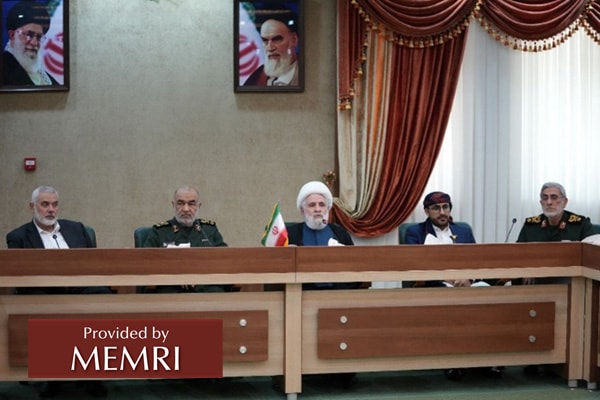
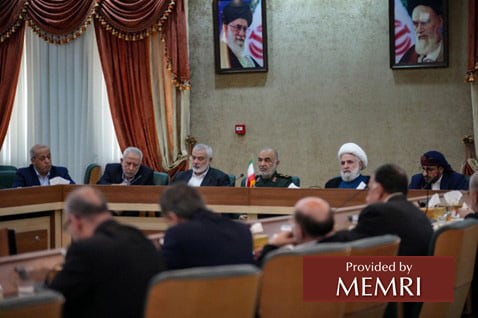
The heads of the resistance axis meet in Iran on the sidelines of Raisi's funeral (Image: Alalam.ir, May 23, 2024)
The Bilateral Level:
The war also provided an opportunity for the members of the axis to tighten their bilateral cooperation.
Tightening Cooperation With Palestinian Factions:
According to Jaafar Al-Husseini, spokesman for the Iraqi Hizbullah Brigades, the ties between the Palestinian factions and the Iraqi militias have grown stronger since October 7 and there is "direct and daily" coordination between them on the political and military levels. The faction heads speak to each other by phone, and the heads of the Palestinian factions have visited Iraq.[11] In June it was reported that Hamas had opened a Baghdad bureau and was considering moving the bulk of its operations from Qatar to Iraq, due to the pressures exerted by Qatar on it.[12]

Palestinian Islamic Jihad (PIJ) delegation meets with Qais Al-Khaz'ali, secretary-general of the Shi'ite Asaib Ahl Al-Haqq movement (Image: Jehad.ps, April 18, 2024)
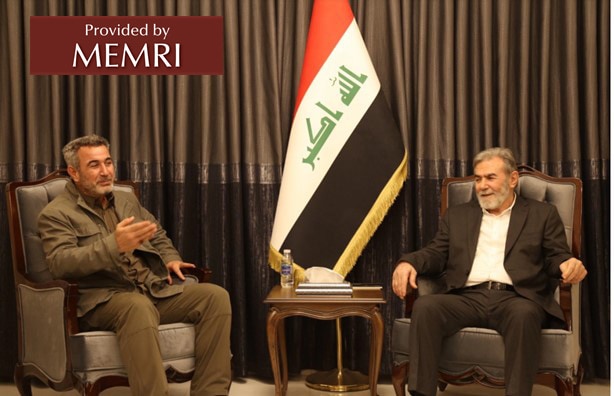
PIJ secretary-general Ziad Al-Nakhaleh with PMU commander Abd Al-Aziz Al-Muhammadawi (Image: Jehad.ps, April 18, 2024)
Military And Operational Cooperation With The Houthi Ansar Allah Movement:
In June there were also reports of joint rocket and drone attacks by the Houthis and the Iraqi militias against targets inside Israel. No further information is available about the cooperation between the two sides, but the claims of responsibility imply that this cooperation enables the Houthis to vary their targets and to reach targets further to the north, which may mean that the attacks are carried out by the Iraqi militias from Iraq or Syria, possibly with Houthi weapons. Also in June, Arab news websites reported that the Houthis were training under IRGC oversight at PMU bases in Iraq, including in the operation of drones.[13]
It should be noted that the growing cooperation among these elements constitutes a threat not only to Israel but also to Saudi Arabia and the U.S. The Houthis have recently escalated their threats against Saudi Arabia, warning it not to act against Yemen, militarily or economically.[14] The Shi'ite militias have likewise threatened to take action against Saudi Arabia, on the grounds that it aids Israel and threatens the Houthis in Yemen.[15] In July 2024, it was reported that the Houthis had opened an office in Baghdad.[16] According to Aziz Rashed, "affiliated with the [Houthi] defense ministry," the Houthis have had a representation in Iraq for several years now,[17] but they chose to highlight its existence at the present time as a "message" to Saudi Arabia and the U.S. that the cooperation with the Iraqi militias can also be directed against them. He said that the Houthis intend to expand their attacks in the region to include not only Israel but also its "defenders in the region, first and foremost the American bases," and that the attacks against Saudi Arabia will not be launched from Yemen but from "many other directions and elements." Rashed stated that the recent public visit of Houthi representative Abu Idris Al-Sharafi to the headquarters of the PMU in northern Baghdad was "a clear message that Sanaa intends to increase the joint operations and the unity of the arenas and the fronts," and that the relationship between the PMU and the Houthis is "a unity that cannot be broken."[18]
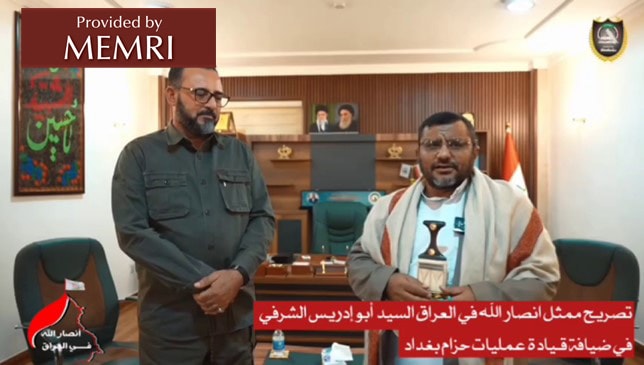
Abu Idris Al-Sharafi with Nasser Al-Shammari, the deputy secretary-general of Al-Nujaba and commander of the PMU's "Baghdad Belt" operations room (Image: Telegram.me/ansarallah_iraq, July 4, 2024)
Alongside their cooperation and coordination with the other members of the resistance axis, the Iraqi militias claim – perhaps to prevent criticism from within Iraq – that they make their own decisions and take local Iraqi interests into consideration. For example, on March 19 the Hizbullah Brigades announced that its secretary-general, Abu Hussein Al-Hamidawi, had met in Tehran with "resistance axis leaders from inside Iraq and abroad." The meeting took place about six weeks after the organization announced it was suspending its attacks on U.S. targets. Implying that this announcement had met with criticism from elements in the resistance axis, the statement stressed that the Islamic Resistance in Iraq "takes timing into consideration, interacts with the main challenges, and manages its decisions with wisdom and deliberation." At the same time, it clarified that the decision to suspend the attacks against the U.S. was "not the end of the matter" and that "the resistance can rely on its own capabilities to manage a long-term battle."[19]
In several instances, there were clear attempts by members of the resistance axis to distance Iran from responsibility for attacks in order to protect it from an American or Israeli retaliation. These elements claimed that they operate independently and that Iran even attempted to dissuade them from escalating their attacks. A January 30, 2024 statement by the Hizbullah Brigades about the suspension of the attacks against the Americans said that Iran had advised not to increase the attacks.[20] And on June 22, a report in the Hizbullah-affiliated Lebanese daily Al-Akhbar claimed that Iran had tried to dissuade the Iraqi militias from fighting alongside Hizbullah in South Lebanon so as to avoid expanding the war in the region.[21] Despite these attempts, several Iranian officials admitted that Iran leads and directs the resistance axis, including the Iraqi militias. In an interview with the IRGC-affiliated Tasnim news agency, General Mohsen Chizari, the Qods Force deputy operations commander, said that Iran's Supreme Leader Khamenei "is the commander of the resistance axis" and that "he alone is the guide, the leader, and the commander" of this axis.[22]
Attacks Against Israel: Details, Goals, Targets, Weapons And Effects
As of this writing, the militia's attacks against Israel have primarily involved rockets, missiles and suicide drones. As previously mentioned, at the beginning of the Gaza war, the Shi'ite militias in Iraq used the war to end their year-long suspension of the attacks against American targets, and resumed these operations, mainly in Syria and Iraq, on the grounds that the U.S. supports Israel.[23] On November 2, the Islamic Resistance in Iraq published its first claim of responsibility for an attack in Israeli territory, claiming to have hit a "vital target" on the shores of the Dead Sea. The statement did not provide any details about the target or about the weapon used against it.[24] On the following day, the group claimed an attack on a target in Eilat,[25] and on November 11 it claimed to have hit another target in Eilat with "the appropriate weapons."[26]
In December 2023, the Islamic Resistance in Iraq issued four additional claims of responsibility for operations against Israel, some of them involving suicide drones, and shared footage of these drones being launched. The purported strikes included a drone attack against Eilat, a strike on "a target in the Mediterranean Sea," an attack against a "key target" south of the Israeli locality of Eliad in the Golan Heights, and an attack on a "military target" in the Golan Heights.[27] A statement by the Israeli authorities confirmed that an attack had indeed taken place in Eliad, causing property damage. None of the other purported attacks were confirmed by Israeli sources.
The claims of responsibility increased in January 2024, with 11 purported attacks. During this month, the militias declared the beginning of the "second phase" of their operations, in which they intended to besiege Israel by targeting airports, seaports and targets in the Mediterranean Sea.[28] The claimed attacks during January were against Eilat, the Golan Heights, Haifa, the Jordan Valley, the Ashdod port, and the "Zevulun naval facility."[29]
February 2024 saw a decrease in the militias' attacks against Israel, as well as against American targets in Iraq and Syria, and in total the militias claimed to have carried out only four attacks against the port of Haifa, Eilat, the shores of the Dead Sea and the Golan Heights.[30]
March 2024 marked the beginning of another significant increase in the attacks against Israel claimed by the militias, after the latter announced a ceasefire in their attacks against American targets on the backdrop of a series of repeated American airstrikes against militia targets and American threats to expand the scope of the airstrikes. The militias' claimed attacks in March were primarily against Israeli infrastructure targets and consisted of 16 purported attacks against a chemical plant, a refinery and powerplant in the port of Haifa, the municipal airport in Kiryat Shmona, the town of Rosh Pina, Ben Gurion International Airport, a powerplant in Tel Aviv, the "defense ministry headquarters," and Israel Air Force intelligence bases in the Golan Heights, in Palmachim and in Uvda.[31] Israeli authorities did not report any strikes or interceptions in Israeli territory due to these attacks. In this context, it should be noted that the London-based Al-Arabi Al-Jadid daily reported that Jordanian security forces found debris of a drone in the city of Irbid in northern Jordan and assessed that the drone had originally been launched from Syria and not from Iraq.[32]
The surge in attacks continued in April 2024, during which the militias claimed to have carried out 22 attacks against Israeli targets, including Eilat; Israel Air Force basses in Tel Nof, Ramat David, Hatzerim and Uvda; military bases in the Golan Heights and in southern Israel, and airports and oil facilities in Haifa, Ashdod and Ashkelon.[33] During this month, Israeli authorities confirmed that a suicide drone launched from the east (i.e., from Iraq) flew through Jordanian airspace and dealt damage to a structure in a naval base in Eilat.
According to an April 23, 2024 infographic marking 200 days of war, published by pro-militia Telegram channels, approximately one-quarter of the militias' attacks during that period were towards Israeli territory (65 out of a total of 243 – although the militias in fact only claimed responsibility for 57 attacks).[34]
In May 2024, the militias claimed over 40 attacks, including one against the Leviathan offshore natural gas field. Despite the militias' claims that most of the attacks resulted in direct hits, the Israeli military reported the interception of only one suicide drone from the east that month, on May 6.[35]
June 2024 saw a decrease in the purported strikes against Israel, with the militias claiming only 24 operations.[36] Notably, some of them were carried out "jointly" with the Yemen-based Houthi Ansar Allah movement. According to this movement, one of these attacks targeted three ships in the port of Haifa, two of which were "carrying military equipment" while the third had "violated the decision to ban entry to the ports of occupied Palestine." By contrast, the Iraqi militias did not provide any details about the targets of the attack.[37]
In July there were 14 strikes, some of them carried out in collaboration with the Houthis. As stated, one of them targeted the Hedera powerplant. A video published July 17 by the Islamic Resistance in Iraq shows Al-Nujaba secretary-general Akram Al-Kaabi helping to prepare a drone for an attack on Eilat. This was the first time a senior militia official was documented taking part in a military operation. Probably due to operational security considerations, the claim of responsibility published along with the video did not specify the date of the attack."[38] The London-based Qatari daily Al-Arabi Al-Jadid stated that it had likely been launched from Syria.[39] It should be noted that, on July 14, Israel announced that it had attacked Syrian army facilities "in response to the launch of two drones from Syrian territory to the region north of Eilat, which were intercepted."[40] The resistance did not issue any claim of responsibility for an attack on Eilat on that date, so this may be the attack in which Al-Kaabi participated.
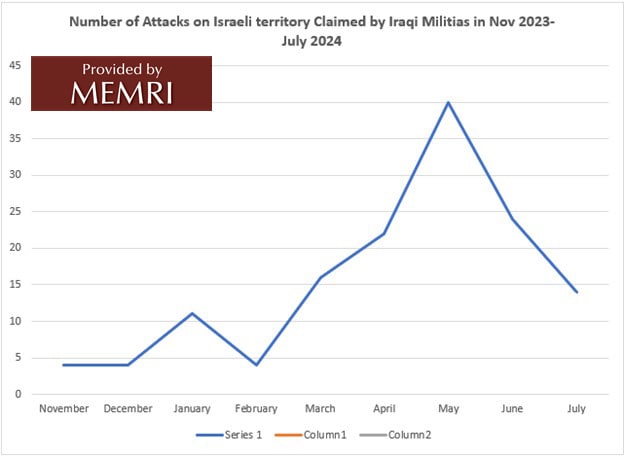
It should be noted that, on May 30, 2024, a group called Saraya Awliya Al-Dam[41] claimed to have launched two suicide drones towards "vital targets" in the port of Haifa. Since then, the group has claimed four additional strikes against Israel: Two against in the port of Haifa, one against the powerplant in Caesaria, and another against a "espionage" base in the Golan Heights.[42]
Weapons Used
According to the militias, the strikes against Israel have been carried out with missiles and drones, and new and more advanced models are gradually being introduced. The longer the conflict lasts, the more the militias can be expected to use new weapons against Israel – as has been openly declared by Abu Alaa Al-Walai, the leader of the Sayyed Al-Shuhada Brigades, an Iran-backed Iraqi militia that has been participating in the attacks as part of the Islamic Resistance in Iraq. In a televised speech in early June 2024, Al-Walai said that the "third phase" of attacks would begin "very soon" and would involve the use of advanced weapons.[43]
Suicide Drones
Based on the militias' statements, most of the attacks have involved suicide drones. Initially they relied primarily on the Murad-5 drone, which is based on the Iranian Shahed-101 drone, and is 1.6 meters long with a wingspan of 2.2 meters. According to an IRGC-affiliated Telegram channel, this drone has significant explosive and strike radius capabilities.[44]

Murad-5 suicide drone
In May, the militias announced that they had started using Al-Arfad-type suicide drones, which, according to a pro-militia Telegram channel, is the Iranian Shahed-136 drone.[45] The Hizbullah-affiliated Al-Maydeen news website reported that the Al-Arfad drone is very similar to the Samad-type drone used by the Houthis.[46]
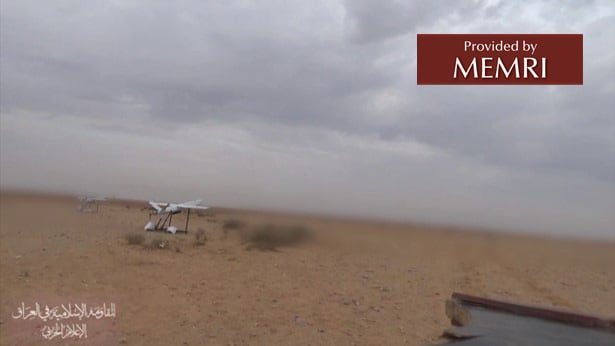
An Al-Arfad drone (Image: T.me/ElamAlmoqawama, May 14, 2024)/p>
Missiles
In January 2024, the militias claimed to have launched Al-Arqab-type cruise missiles towards Israel. An IRGC-affiliated Telegram channel reported that these are Iranian Paveh-351 cruise missiles, known also by their Houthi designation "Al-Quds."[47] These cruise missiles have a range of approximately 1,000 kilometers, can change trajectory mid-flight, and use a turboshaft engine that enables them to avoid detection by radar systems by flying at low altitudes.[48]

Graphic showing an Al-Arqab cruise missile, which the militias claim to have fired towards Haifa in January 2024 (Image: T.me/elamharbi, January 8, 2024)
The Northern Threat: Iraqi Militia Operations In Southern Syria And Lebanon
Some of the drones and missiles are launched by the Iraqi militias from Syrian territory. This is evident from a March 2024 report in Al-Arabi Al-Jadid stating that Jordanian security forces found debris from a suicide drone in Jordan's northern city of Irbid, assessing that the drone had been fired towards Israel from Syria.[49] Israel too has claimed that missiles and rockets were launched into its territory from Syria and has attacked in Syria in response.[50]
In recent years, Syria has been a key stronghold for Iraqi militias, which established their presence in the country during the Syrian civil war that broke out in 2011, under the pretext of fighting ISIS and defending Shi'ite holy sites in Syria. Over time, the true reason for the militias' presence in Syria became apparent: to attack Israel. The militias have deployed forces and established outposts in southern Syria, along its borders with Jordan and Israel. Some of these operations have been disguised as operations of the Syrian military. In March 2017, the Al-Nujaba militia announced that it was establishing the Golan Liberation Army and that this army had "detailed plans."[52]
The militias have been establishing their presence in these regions with the consent of the Syrian regime, and the process has been ignored by Russian forces deployed in the area, despite the understandings made between Israel, Jordan and Russia in 2018 according to which Russia was to push for the withdrawal of the Iran-backed militias from southern Syria.[53]
Since October 7, there have been growing indications that a widescale operation might be launched against Israel from the Syrian front: the militias there have increased their readiness, additional fighters have been sent to southern Syria, and the militias have openly declared that they intend to open a new front in the Golan Heights.[54] It is not inconceivable that, if the scope of the war expands, for instance against Hizbullah, the militias will launch a ground offensive against Israel.
Another front from which the militias are threatening to attack is Lebanon. On October 15, 2023, a pro-militia Telegram channel shared a video of Ayoub Faleh Hassan Al-Ruba'i, aka Abu Azra'il, a senior official in the Iraqi PMU's Imam Ali Brigades, allegedly speaking from southern Lebanon, and threatening that, if given the order to do so, his group would take action against Israel.[55]
Recently, on the backdrop of the escalation between Israel and Hizbullah and the possibility of the outbreak of a full-blown war between them, militia spokespersons have declared that, if needed, they would not suffice with missile and drone attacks from a distance but would also send forces to southern Lebanon to fight alongside Hizbullah. Such declarations demonstrate the militias' obligation to Hizbullah, and the importance of Hizbullah for Iran, when compared to the Palestinian factions.
As early as January 2024, Jaafar Al-Husseini, the spokesperson for the Iran-backed Iraqi Hizbullah Brigades militia, warned that, if Israel escalates the fighting against Hizbullah, his group will fight "shoulder to shoulder" alongside the Lebanese organization.[56] Similarly, Sayyed Al-Shuhada Brigades militia leader Abu Alaa Al-Walai warned on June 25, 2024 that, if Israel expands its attacks against Hizbullah, the obstacle of distance that prevented the militias from actively fighting alongside the Palestinian factions will be "removed" and the fighting will take place "at zero distance." He added that the entire military arsenal of the resistance will be put to use.[57]
The Hizbullah-affiliated Lebanese daily Al-Akhbar reported that, after their June 13, 2024 meeting in Baghdad with Iranian interim foreign minister Ali Bagheri Kani, the Hizbullah Brigades and Al-Nujaba militias declared their readiness to fight alongside the Lebanese Hizbullah "if it agrees to this." Kazem Al-Fartousi, the spokesperson for the Sayyed Al-Shuhada Brigades militia, explained that Hizbullah has great military capabilities, "high-quality" equipment, and "many fighters," but that "if the situation demands the presence of fighters from Iraq in South Lebanon, we will be on the front of resisting the Zionist aggression, since this is an Islamic and Arab matter that erases all borders and definitions."[58]
In late June 2024, two Arab journalists claimed that "hundreds" of Iraqi militia operatives had entered Lebanon ahead of a possible escalation in Israel's war with Hizbullah.[59]
As of this writing, Hizbullah claims that it has denied the request of non-Lebanese elements to join the fighting from Lebanese soil. In a June 19 speech, Hizbullah leader Hassan Nasrallah said: "The leaders of the resistance movements contacted us and wanted to send fighters, but we told them that we have more than enough fighters."[60]
The Threat From Jordan: Iran Aims To Open A Jordanian Front Against Israel, With Help From The Iraqi Militias
Even before October 7, Israel identified Iranian attempts to smuggle weapons into the West Bank from Jordan. These efforts intensified after October 7, and in November 2023 Israel's security agencies reportedly captured 137 weapons that were being smuggled in from Jordan.[61]
In addition to smuggling weapons into the West Bank, Iran is attempting to exploit the war in Gaza and the solidarity with the Palestinians to establish a presence in Jordan by means of militias and other elements that are loyal to it. The long-term goal of this activity is to undermine and ultimately topple the Jordanian regime, and to deploy forces loyal to Iran along Israel's eastern border, in order to smuggle weapons into the West Bank and eventually carry out attacks against Israel from Jordanian soil.[62]
In early April 2024, the militias openly declared that these were their intentions. Senior Iraqi Hizbullah Brigades official Abu Ali Al-Askari announced that his group is working to arm operatives in Jordan. Iraqi MP Ali Fadhlallah, who belongs to the Hizbullah Brigades' political party, admitted that the group aims to establish a militia in Jordan that will also assist in action against the U.S. Fadhlallah said that "Jordan is very important to the resistance axis" and that the group aims to "activate the dead front in Jordan so that it supports the factions in Palestine." It has been reported that, since October 7, Jordanian authorities have foiled several attempts by Iraqi militants to infiltrate Iraqi territory as part of aid convoys for the Palestinians.[63]
* N. Mozes is a research fellow at MEMRI.
[1] Telegram.me/ElamAlmoqawama, July 10, 2024.
[2] On July 16 two drones were fired at the Ayn Al-Assad base in Iraq (Reuters.com, July 17, 2024), and on July 26 drones were fired at this base and at the Conoco base in Syria (Arabnews.com, July 26, 2024).
[3] Al-Akhbar (Lebanon), July 27, 2024. See MEMRI JTTM report: New Organization Affiliated With 'Islamic Resistance In Iraq' Claims Three Attacks Against U.S. Bases; Lebanese Daily 'Al-Akhbar' Quotes 'Resistance Sources:' U.S. Must Withdraw Troops From Iraq Within Two Months, July 28, 2024.
[4] See MEMRI Special Dispatch No. 7033, Resistance Axis Sources: PMU Has Close Ties With Iran, Hizbullah, Opposes U.S. Presence In Iraq, July 31, 2017
[5] See MEMRI JTTM report, Leaders Of Iran-Backed Militias In Iraq Vow Support To Palestinian Factions In Hamas Attack, Threaten To Respond To Any Israeli Or American Attack Against Them, October 7, 2023.
[6] See MEMRI JTTM report, Iran-Backed Islamic Resistance In Iraq Claims Drone Attack On Israel's Ministry Of Defense; Iraqi Militia Leader Threatens To Attack Israeli Infrastructure And Ports, Says 'The Time Of The Resistance Is At Hand', March 24, 2024.
[7] See MEMRI JTTM report, Iran-Backed Islamic Resistance In Iraq Claims Missile Attacks Against Israel: Hizbullah-Affiliated Al-Mayadeen Identifies Targets, Al-Nujaba' Movement Member: Iraqi Resistance 'Has A Very Large Target Bank', May 3, 2024.
[8] See MEMRI JTTM report, At Meeting In Tehran, Head Of Iraqi Hizbullah Brigades Declares Suspension Of Attacks On U.S. Forces Not End Of 'Long-Term Battle'; Arab Daily: No Intention To Resume Attacks In Near Future, March 20, 2024.
[9] See MEMRI JTTM report, Media Outlets Affiliated With Resistance Axis: In Rare Meeting Between Heads Of Iran's IRGC And Qods Force And Representatives Of Resistance Factions, Participants Pledge To Continue Jihad Against Israel Until "Complete Victory Of Resistance In Gaza", May 23, 2024.
[10] Al-Akhbar (Lebanon), June 3, 2024.
[11] See MEMRI JTTM reports: Hizbullah Brigades Leader Promises Hamas: We'll Spare No Effort, Blood, Or Money To Assist Gaza,May 19, 2024; Leader Of Iran-Backed Iraqi Militia Meets With Designated Hamas Terrorist In Baghdad, Reiterates His Support Of The Palestinian Cause, October 30, 2023; Spokesman Of Iraqi Hizbullah Brigades Says Coordination With Palestinian Factions Expanded On All Levels, Threatens To Attack UAE, Claims Iran's Axis Of Resistance Will Strech To East Asia, Caucasus, January 9, 2024.
[12] See MEMRI JTTM report, Outlet Affiliated With Iran-Backed Iraqi Militia Publishes Photos Showing Leaders Attending Inauguration Of Hamas Office In Baghdad, Anti-Iran Account On X: New Office To Test Whether Baghdad Suitable Alternative For Hamas Top Leadership In Qatar, June 24, 2024.
[13] See MEMRI JTTM report, Arab Media Outlets: Yemen's Houthi Ansar Allah Movement And Some Iraqi Resistance Factions Comprise Joint Operations Room Run By Iran and Hizbullah; Iraqi PMU Trains Houthi Forces In Iraq, June 16, 2024.
[14] See MEMRI JTTM report, Houthi Ansar Allah Movement Claims Six Missile And Drone Attacks Against 'U.S.,' 'Israeli,' And Other Targets; Houthi Leader: Targeting Banks, Seaports And Airports Is 'Red Line'', July 14, 2024; Senior Houthi Ansar Allah Movement Offifficials Warn Saudi Arabia If It Joins Fighting Against Them 'No Place Will Be Safe For Investments,' Including Saudi Mega-Project NEOM On Red Sea, July 9, 2024; and Pro-Hizbullah Lebanese Daily: Houthi Ansar Allah Movement Threatens Saudi Arabia With Return To War, Plans To Begin 'Fifth Stage' Of Maritime Attacks, July 7, 2024.
[15] Al-Akhbar (Lebanon), July 15, 2024. See also, MEMRI JTTM report, Iran-Backed Iraqi Hizbullah Brigades Threatens Revenge On Saudi Arabia For Using Its Land Routes To 'Preserve Momentum' Of Gaza War: 'Kingdom Of Evil Will Pay For Its Actions', July 14, 2024.
[16] See MEMRI JTTM report, Yemen's Houthi Ansar Allah Movement Opens 'Representation Office' In Baghdad, Houthi Representative Visits PMU Operation Room, Meets With Iraqi Shi'ite Tribes, July 8, 2024. An advisor to the Iraqi government denied that the Houthis had opened an official representation, stating that members of the Houthi movement had only "opened an office after previously staying at a hotel in the capital" (Al-Arabi Al-Jadid, London, July 8, 2024).
[17] According to reports in the Arab press, Houthi elements have been in Iraq since 2016 (Al-Arabi Al-Jadid, London, July 8, 2023). In the past year, the Houthis have increased the visibility of their operations there and have been posting messages on Telegram and X (formerly Twitter) about their activities in the country, which mostly comprise visits to Iraqi tribes and placing billboards bearing Houthi slogans (such as "Death to America" or "Death to Israel") on the streets of Iraq (telegram.me/ansarallah_iraq, July 14, 22, 2023, May 28, 2024; twitter.com/ansarallah_iraq, July 14, 22, 2023, May 28, 2024.
[18] Al-Akhbar (Lebanon), July 12, 2024.
[19] See MEMRI JTTM report, At Meeting In Tehran, Head Of Iraqi Hizbullah Brigades Declares Suspension Of Attacks On U.S. Forces Not End Of 'Long-Term Battle'; Arab Daily: No Intention To Resume Attacks In Near Future, March 20, 2024.
[20] See MEMRI JTTM report, Iran-Backed Hizbullah Brigades In Iraq Announce Suspension Of All Operations Against U.S. Forces, Denies Iran's Involvement In Previous Attacks, Says Teheran Often Advised Against Escalation, January 30, 2024.
[21] Al-Akhbar (Lebanon), June 22, 2024.
[22] See MEMRI Special Dispatch No. 11392, IRGC Qods Force Deputy Operations Chief Gen. Mohsen Chizari On Qods Force Deputy Commander In Syria And Lebanon Hajj Rahimi, Killed In Damascus: Supreme Leader Ali Khamenei 'Directs, Leads, And Commands' The Resistance Axis; Under Him, The Resistance Axis Commanders – Including Hajj Rahimi – Successfully 'Advanced The Resistance Front To A Certain Place, The Result Of Which Was Operation Al-Aqsa Flood [On October 7, 2023]', June 11, 2024.
[23] According to an infographic published by the militias, between October 7 and November 25, 2023, 78 such attacks had been carried out, including 36 against American targets in Syria and 39 against American targets in Iraq (T.me/elamharbi, November 25, 2023).
[24] See MEMRI JTTM report: Iran-Backed 'Islamic Resistance In Iraq' Claims Attack Against Israeli Target On Dead Sea Coastline,, November 2, 2023.
[25] See MEMRI JTTM report: Iran-Backed 'Islamic Resistance In Iraq' Claims Attack Against Israeli Target In Eilat, November 3, 2023.
[26] It should be noted that, at the time of the announcement, an unknown group called "SWAT of the Arabian Peninsula" also claimed to have fired drones towards Eilat. See MEMRI JTTM Report Islamic Resistance In Iraq Claims Attacking U.S. Bases In Iraq, Syria, Israeli City Of Eilat; New Unknown Group 'SWAT Of The Arabian Peninsula' Claims Attacking Eilat With Two Suicide Drones, November 12, 2023.
[27] See MEMRI JTTM report: Iran-Backed Islamic Resistance In Iraq Claims Attacks On U.S. Base In Northeastern Syria, Moshav In Golan, 'Israeli Espionage' Center In Iraq, December 28, 2023.
[28] See MEMRI JTTM report: Following U.S. Strikes In Iraq, Iran-Backed Iraqi Militias Call For Mass Demonstrations Against 'Embassy Of Evil' In Baghdad And 'Crushing Of Enemies' Strongholds;' Welcome New Phase Of 'Blockade Of Zionist Shipping In Mediterranean Sea', January 24, 2024.
[29] See MEMRI JTTM reports: Iran-Backed Islamic Resistance In Iraq Claims Series Of Rocket, Drone Attacks On U.S. Bases In Eastern Syria, Northern Iraq; Alleges It Is Targeting Sites In Israel's Eilat, Golan Heights Using Undisclosed Weaponry, January 2, 2024; Iran-Backed Islamic Resistance In Iraq Claims Rocket Attack On Haifa In Northern Israel; Al-Nujaba Movement Spokesman: 'Resistance Isn't Reneging On Strategic Goals In Region;' Goal Is To Disrupt U.S. Plan, January 8, 2024; The Islamic Resistance In Iraq Claims Responsibility For Attacks In Northern, Southern Israel, January 14, 2024; Iran-Backed Islamic Resistance In Iraq Claims Attacking 'Vital Target' In Israel With Long-Range Cruise Missile, Base In Syria Allegedly Housing U.S. And Israeli Intelligence, January 17, 2024; Iran-Backed Islamic Resistance In Iraq Claims Hitting American Drone In Eastern Iraq; Drone, Rocket Attacks On U.S. Bases In Eastern Syria, Northern, Western Iraq; Drone Attack Against 'Military Target' In Israel's Golan, January 22, 2024; Iran-Backed Islamic Resistance In Iraq Claims Spate Of Missile And Drone Attacks On U.S. Forces In Syria And Iraq; Drone Attack On Israeli Port Of Ashdod, January 23, 2024; T.me/elamharbi, January 7, 2024.
[30] See MEMRI JTTM reports: Iran-Backed Islamic Resistance In Iraq Claims Drone Attack Against Port Of Haifa In Northern Israel, February 1, 2024; Iran-Backed Islamic Resistance In Iraq Claims Drone Attack On Israel's Eilat, February 6, 2024; Iran-Backed Islamic Resistance In Iraq Claims Attack On Israeli Target At Dead Sea; Exhorts 'Brothers In Jihad' To 'Take Active Role In Expulsion Of Occupation', February 11, 2024; Iran-Backed Islamic Resistance In Iraq Claims Drone Attack On 'Military Target' In Israel's Golan Heights, February 20, 2024.
[31] See MEMRI JTTM reports: After More Than Two-Week Hiatus, Islamic Resistance In Iraq Renews Attacks On Israeli Territory; Claims Drone Strike On Haifa Chemical Plant, March 4, 2024; Iran-Backed Islamic Resistance In Iraq Claims Two Drones Attacks On Power Stations In Israeli Airports As Part Of 'Second Phase' Of 'Resistance Operations' Against Israel, March 10, 2024; Iran-Backed Islamic Resistance In Iraq Claims Drone Attacks Against Military Bases, Refineries In Northern Israel; Threatens Attacks Will Continue As Long As War In Gaza Continues, March 10, 2024; Iran-Backed Islamic Resistance In Iraq Claims Drone Attack Against Israel's Ben Gurion Airport, March 12, 2024; Iran-Backed Islamic Resistance In Iraq Claims Drone Attack Against Palmachim Airbase In Central Israel, March 14, 2024; Iran-Backed Islamic Resistance In Iraq Claims Drone Attack On Israeli Airbase In Golan Heights, March 19, 2024; Iran-Backed Islamic Resistance In Iraq Claims Drone Attacks Against Israeli Ben Gurion Airport and Tel Aviv Power Plant, March 21, 2024; Iran-Backed Islamic Resistance In Iraq Claims Drone Attack On Israel's Ministry Of Defense; Iraqi Militia Leader Threatens To Attack Israeli Infrastructure And Ports, Says 'The Time Of The Resistance Is At Hand', March 24, 2024; Iran-Backed Islamic Resistance In Iraq Claims Drone Attacks Against Airbase In Southern Israel, Israeli Military Site, March 27, 2024; T.me/ElamAlmoqawama, March 6, 2024.
[32]See MEMRI JTTM report: Iran-Backed Islamic Resistance In Iraq Claims Drone Attack Against Palmachim Airbase In Central Israel, March 14, 2024.
[33] See MEMRI JTTM reports: Iran-Backed Islamic Resistance In Iraq Claims Drone Attacks Against 'Military, Vital' Targets In Northern Israel; Hit Reported In Israel's Eilat Following Group's Claim Of Attacking 'Vital Target', April 1, 2024; Iran-Backed Islamic Resistance In Iraq Claims Drone Attack Against Airbase In Central Israel, April 2, 2024; Iran-Backed Islamic Resistance In Iraq Claims Drone Attack on "Haifa Airport"; Iraqi Al-Nujaba Movement: Killings Of Senior IRGC Officials In Damascus Is "Declaration Of War" On Iran And We Are Ready To Respond To It, April 3, 2024; Islamic Resistance In Iraq Claims Responsibility For Two Drone Attacks On Israel, April 4, 2024; Iran-Backed Islamic Resistance In Iraq Claimed Three Drone Attacks And Another Unspecified Attack On Targets In Israel; Iraqi Al-Nujaba Leader: We Will Yet Reach More Important Targets, April 7, 2024; Attacks On Israeli Military Bases; Telegram Channel Supporting Iran-Backed Iraqi Militias Claims Militias Have Conducted 14 Operations Against Israeli Targets Since March 29, April 8, 2024; Islamic Resistance In Iraq Claims Additional Attacks On Israeli Targets; Telegram Channels Provide Details About Missiles Used, April 11, 2024; Following Explosion At Popular Mobilization Unit (PMU) Base, Iraqi Militia Leader Threatens Perpetrators "Will Pay;" Iran-Backed Islamic Resistance In Iraq Claims Three Drone Attacks On Israel, April 21, 2024.
[34] See MEMRI JTTM report: Marking 200 Days Of Gaza War, Hizbullah, Houthi Ansar Allah Movement, Iran-Backed Militias In Iraq, Claim 1,998 Operations Against Israel From 'The Assistance Fronts' For Gaza, From Lebanon, Yemen, Iraq, April 24, 2024. It should be noted that a different infographic published by a militia-affiliated source claimed that approximately one-third of the attacks – 88 out of 243 – were aimed at Israel. See MEMRI JTTM Report: Iran-Backed 'Islamic Resistance in Iraq' Claims April 26 Drone Attack On Haifa, Israel, Supporting Telegram Outlet Claims Group Has Launched 243 Attacks In Past 200 Days, April 29, 2024. In both infographics, the number of claimed attacks does not match the actual number of attacks the militias have claimed responsibility for (57).
[35] See MEMRI JTTM reports: Iran-Backed Islamic Resistance in Iraq Claims Two Drone Attacks Against Israeli Targets In Golan Heights And Eilat, May 2, 2024; Iran-Backed Islamic Resistance In Iraq Claims Missile Attacks Against Israel: Hizbullah-Affiliated Al-Mayadeen Identifies Targets, Al-Nujaba' Movement Member: Iraqi Resistance 'Has A Very Large Target Bank', May 3, 2024; Iran-Backed Islamic Resistance In Iraq Claims Responsibility For Three Missile And Drone Attacks Against Israel, Threatens To Continue "Pounding The Enemy's Strongholds", May 6, 2024; Iran-Backed Islamic Resistance In Iraq Documents Drone Launches On Israeli Targets, Claims Missile, Drone Attacks Against Port In Southern Israel, Israeli Gas Field, Military Bases, May 7, 2024; Iran-Backed Islamic Resistance In Iraq Claims It Fired A Cruise Missile And One-Way Drones Against 'Vital' Sites In Southern Israel, May 9, 2024; Iran-Backed Islamic Resistance In Iraq Claims Six Attacks Against Israeli Targets Including Military Bases, Leviathan Gas Field, May 13, 2024; Iran-Backed 'Islamic Resistance In Iraq' Claims Attack On Eilat, Israel Using New Type Of Drones, May 14, 2024; Iran-Backed 'Islamic Resistance In Iraq' Claims Three Attacks Against Israel In Past 48 Hours, May 16, 2024; Iran-Backed Islamic Resistance In Iraq Claims Three Drone Attacks On Israel In Four Days, May 20, 2024; Iran-Backed Islamic Resistance In Iraq Claims Drone Attacks Against 'Vital Target' In Israel's Eilat, 'Zionist Drone Base' In Israel's Golan Heights, May 22, 2024. See also: T.me/ElamAlmoqawama, May 23, 24, 25, and 28, 2024.
[36] See MEMRI JTTM reports: Iran-Backed Iraqi Militia Claims Attacks On Haifa, Unusually In Its Own Name, Not As Part Of "Islamic Resistance In Iraq" Umbrella Organization, June 3, 2024; Iran-Backed Islamic Resistance In Iraq Claims Drone Attacks Against 'Vital' Sites In Israel's Eilat, Haifa, 'Military Target' In Golan Heights, June 11, 2024; Resistance In Iraq Claims Attack On Israeli Air Base in Haifa, June 14, 2024.
[37] See MEMRI JTTM reports: Statement By Iran-Backed 'Islamic Resistance In Iraq' Confirms June 6 Attacks Against Israeli Port Coordinated, Executed Jointly With Yemen's Houthi Ansar Allah Movement, June 6, 2024; Houthi Ansar Allah Movement, Islamic Resistance In Iraq Again Claim Joint Attacks On Israeli Port Cities; Houthis Claim Causing Leak Threatening Commercial Ship In Red Sea, June 13, 2024.
[38] See MEMRI JTTM report: 'Islamic Resistance In Iraq' Claims Six Attacks Against Israel Between July 15-21, Including One Houthi-Coordinated Attack, July 22, 2024.
[39] Al-Arabi Al-Jadid (London), July 19, 2024.
[40] X.com/IDFSpokesperson, July 14, 2024.
[41] This group first appeared in August 2020, when it claimed responsibility for an attack against an American military logistical convoy in Iraq, as part of a strategy adopted earlier that year by Iran and its militias according to which various unknown groups claim responsibility for attacks against American forces, with the goal of avoiding U.S. retaliation. For examples, see MEMRI JTTM reports: New Iranian Tactic: Unknown Group Issues Statement Of Responsibility For Attacks On U.S. Forces In Iraq, March 16, 2020; Iran-Backed Shi'ite Militias In Iraq: We Will Declare War Against U.S. Forces If They Don't Leave By End Of 2021, December 30, 2021.
[42] See MEMRI JTTM reports: Iran-Backed Iraqi Militia Claims Attacks On Haifa, Unusually In Its Own Name, Not As Part Of "Islamic Resistance In Iraq" Umbrella Organization, June 3, 2024; Iran-Backed Iraqi Militia 'Saraya Awliya' Al-Dam' Posts Video Of June 14 Drone Attack On Israeli Base In Golan, June 17, 2024.
[43] See MEMRI JTTM report Iran-Backed Iraqi Militia: Islamic Resistance In Iraq To Launch Third Phase Of Operations, Utilizing 'Advanced Weaponry', June 3, 2024.
[44] T.me/iran_military_capabilities, April 1, 2024.
[45] See MEMRI JTTM report: Telegram Outlet Praises Iran-Backed 'Islamic Resistance In Iraq' For Using Iranian-Designed Shahed 136 Drones In Attack On Eilat, Israel, May 15, 2024.
[46] Almayadeen.net, May 14, 2024.
[47] See MEMRI JTTM report: Islamic Resistance In Iraq Claims Additional Attacks On Israeli Targets; Telegram Channels Provide Details About Missiles Used, April 11, 2024.
[48] Infoplusnetwork.com, May 14, 2024.
[49] See MEMRI JTTM report: Iran-Backed Islamic Resistance In Iraq Claims Drone Attack Against Palmachim Airbase In Central Israel, March 14, 2024.
[50] For example, on December 31, 2023 the IDF reported the interception of "a suspicious target entering Israel from Syria" (globes.co.il, December 31, 2023); on March 5, 2024 an IDF plane intercepted a drone coming from Syria (inn.co.il, March 5, 2024), and on July 14 the IDF spokesperson reported that Israel had attacked in Syria in response to the launch of a drone to Eilat (twitter.com/IDFSpokesperson, July 14, 2024).
[51] See MEMRI Special Dispatch No. 6859, Spokesman For Iran-Backed Iraqi Shi'ite Militia In Syria: 'We Have Established The Golan Liberation Army', April 5, 2017.
[52] See MEMRI Inquiry & Analysis Series No. 1340, Websites Opposed To The Syrian Regime: Iran Continues To Consolidate Its Presence In Southern Syria, In Violation Of Understandings Between Russia, Israel, Jordan, January 4, 2019
[53] See MEMRI Special Dispatch No. 10920, Signs That Iran Will Open A Front Against Israel From The Syrian Golan Heights, October 31, 2023.
[54] See MEMRI JTTM Report From Southern Lebanon, Iran-Backed Iraqi Commander Threatens Israel: 'If The Orders Come... Israel Will Be Ground Into Dust', October 16, 2023.
[55] See MEMRI JTTM Report Spokesman Of Iraqi Hizbullah Brigades Says Coordination With Palestinian Factions Expanded On All Levels, Threatens To Attack UAE, Claims Iran's Axis Of Resistance Will Strech To East Asia, Caucasus, January 9, 2024.
[56] See MEMRI JTTM Report Iran-Backed Militias In Iraq: If Israel Goes To War Against Hizbullah, We Will Fight Alongside It In Lebanon; American Support For Israel In Such A Scenario Will Make Every U.S. Interest In The Region A Target, June 25, 2024.
[57] Al-Akhbar (Lebanon), June 22, 2024.
[58] See MEMRI JTTM Report Arab Political Commentators: Hundreds Of Iraqi Militiamen Entered Lebanon Recently, Some To Assist Hizbullah If And When It Decides To Seize Total Power, July 3, 2024.
[59] Al-Manar (Lebanon), June 19, 2024.
[60] Ynet.co.il, November 30, 2023.
[61] See MEMRI Inquiry & Analysis Series No. 1757, Iran's Grand Plan: Bring Down The Jordanian Regime, Attack Israel From The East, And Thwart The Western-Sunni Normalization Project – And This Could Begin This Friday, Iran's Qods Day, April 3, 2024.
[62] See MEMRI JTTM Report Elements In The Iran-Led Resistance Axis: 'Jordan Is A New Resistance Front', April 5, 2024.




